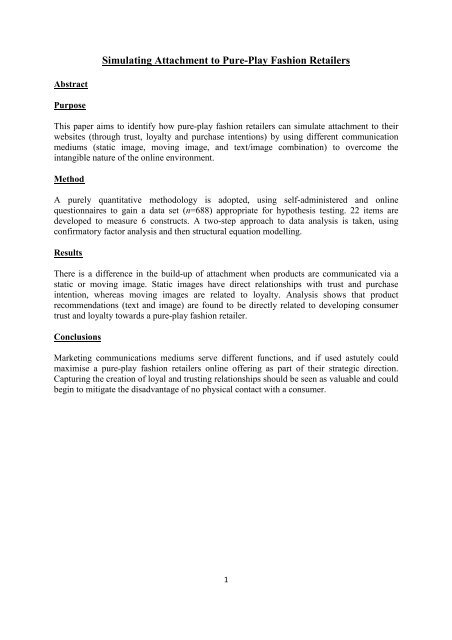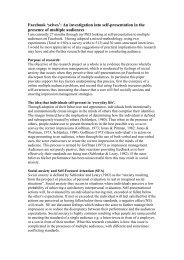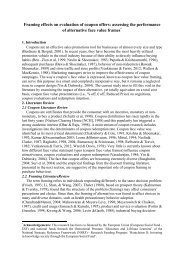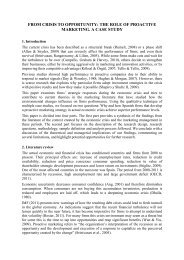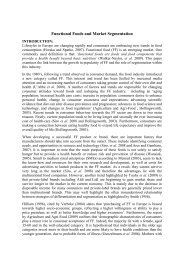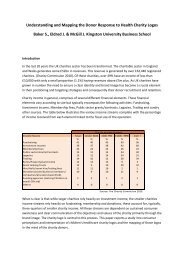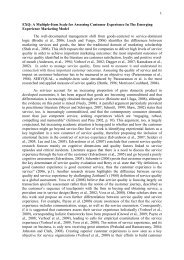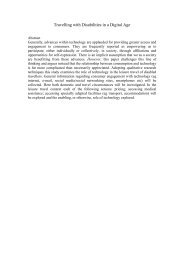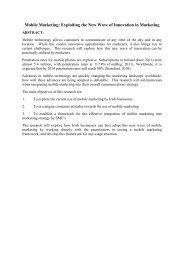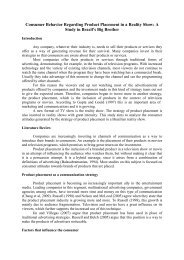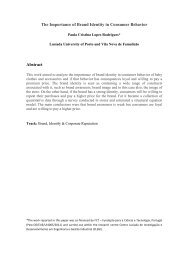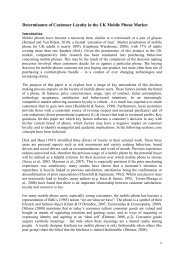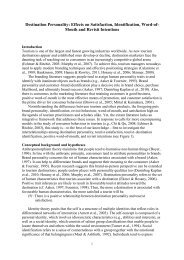Simulating Attachment to Pure-Play Fashion Retailers - Academy of ...
Simulating Attachment to Pure-Play Fashion Retailers - Academy of ...
Simulating Attachment to Pure-Play Fashion Retailers - Academy of ...
You also want an ePaper? Increase the reach of your titles
YUMPU automatically turns print PDFs into web optimized ePapers that Google loves.
Abstract<br />
Purpose<br />
<strong>Simulating</strong> <strong>Attachment</strong> <strong>to</strong> <strong>Pure</strong>-<strong>Play</strong> <strong>Fashion</strong> <strong>Retailers</strong><br />
This paper aims <strong>to</strong> identify how pure-play fashion retailers can simulate attachment <strong>to</strong> their<br />
websites (through trust, loyalty and purchase intentions) by using different communication<br />
mediums (static image, moving image, and text/image combination) <strong>to</strong> overcome the<br />
intangible nature <strong>of</strong> the online environment.<br />
Method<br />
A purely quantitative methodology is adopted, using self-administered and online<br />
questionnaires <strong>to</strong> gain a data set (n=688) appropriate for hypothesis testing. 22 items are<br />
developed <strong>to</strong> measure 6 constructs. A two-step approach <strong>to</strong> data analysis is taken, using<br />
confirma<strong>to</strong>ry fac<strong>to</strong>r analysis and then structural equation modelling.<br />
Results<br />
There is a difference in the build-up <strong>of</strong> attachment when products are communicated via a<br />
static or moving image. Static images have direct relationships with trust and purchase<br />
intention, whereas moving images are related <strong>to</strong> loyalty. Analysis shows that product<br />
recommendations (text and image) are found <strong>to</strong> be directly related <strong>to</strong> developing consumer<br />
trust and loyalty <strong>to</strong>wards a pure-play fashion retailer.<br />
Conclusions<br />
Marketing communications mediums serve different functions, and if used astutely could<br />
maximise a pure-play fashion retailers online <strong>of</strong>fering as part <strong>of</strong> their strategic direction.<br />
Capturing the creation <strong>of</strong> loyal and trusting relationships should be seen as valuable and could<br />
begin <strong>to</strong> mitigate the disadvantage <strong>of</strong> no physical contact with a consumer.<br />
1
Introduction:<br />
Clothing is an experience product, with features that can only be evaluated by trying on or<br />
inspection, dependent on an individual and their own personal requirements (Nelson, 1974).<br />
For those selling clothing online, technology and communications techniques are therefore<br />
instrumental in encouraging consumers <strong>to</strong> buy goods before they carry out their own physical<br />
evaluations. For multichannel retailers, consumers have the option <strong>of</strong> visiting a physical s<strong>to</strong>re<br />
whereby they can engage with the brand, the quality <strong>of</strong> the products and the sizing <strong>of</strong> the<br />
goods on <strong>of</strong>fer. For pure-play fashion retailers this is not possible, and therein lays their<br />
biggest disadvantage. This study attempts <strong>to</strong> go some way <strong>to</strong> answering the question; how can<br />
pure-play fashion retailers stimulate attachment <strong>to</strong> their website when they cannot <strong>of</strong>fer<br />
physical interaction from the shopping experience?<br />
A pure-play retailer has no traditional s<strong>to</strong>refront and can be found solely in the online<br />
marketplace (Ashworth, Schmidt, Pioch & Hallsworth, 2006a). To date there is little research<br />
on pure-play retailers, with previous studies concentrating on their definition (Marciniak &<br />
Bruce, 2004), pricing strategies (Yan, 2008) and pr<strong>of</strong>itability (Goldsmith & Flynn, 2005;<br />
Ashworth, Schmidt, Pioch & Hallsworth, 2006b). With some retailers beginning <strong>to</strong> move<br />
<strong>to</strong>wards category killer status (ASOS.com now claims <strong>to</strong> be the ‘world’s biggest wardrobe’) it<br />
is imperative that there is an increased understanding <strong>of</strong> this retail format.<br />
One fundamental disadvantage <strong>of</strong> pure-play fashion retailing is the lack <strong>of</strong> tactility and<br />
experience a consumer can have with a product prior <strong>to</strong> purchase. Moreover, no human<br />
interactions with s<strong>to</strong>re personnel can be made, and visual merchandising cannot be carried out<br />
easily. In order <strong>to</strong> compete with <strong>of</strong>fline s<strong>to</strong>res a pure-play fashion retailer’s communication <strong>of</strong><br />
its products <strong>to</strong> consumers must be faultless. Understanding the effect that different<br />
communications media have on consumer shopping experiences could go some way <strong>to</strong><br />
reaching this goal. This study models the effects <strong>of</strong> different mediums <strong>of</strong> communication and<br />
how these <strong>to</strong>ols relate <strong>to</strong> aspects <strong>of</strong> consumer attachment.<br />
Shopping Motivations:<br />
In modelling the effects that pure-play communication mediums have on attachment,<br />
understanding <strong>of</strong> the pure-play consumer will increase and links can be made with consumer<br />
shopping motivations. Understanding shopping motivations can help indicate what the pureplay<br />
interface needs <strong>to</strong> deliver <strong>to</strong> stay competitive. Shopping motivations can be utilitarian or<br />
hedonic (Wagner, 2007). Recognized hedonic shopping motivations include enjoyment,<br />
whereas utilitarian motives are ease <strong>of</strong> use and usefulness (Monsuwe, Dellaert & Ruyter,<br />
2004). Hedonic motivations <strong>to</strong> shop include adventure, social, gratification, idea, role and<br />
value shopping (Arnold & Reynolds, 2003). Consumers with high levels <strong>of</strong> fashion<br />
innovativeness are driven by adventure and idea motives and less concerned with value (Kang<br />
& Park-Poaps, 2010). Motivations are also linked <strong>to</strong> cus<strong>to</strong>mer’s evaluation <strong>of</strong> online s<strong>to</strong>re<br />
elements such as visual design, product assortment and information quality (Koo, Kim & Lee<br />
2008). This study attempts <strong>to</strong> increase understanding <strong>of</strong> the links between how consumers<br />
process different communications mediums, the effects on their resulting levels <strong>of</strong> attachment<br />
and the reasons why they choose the shop via a pure-play format.<br />
Theoretical Framework - Communications Theory:<br />
Finding its theoretical origin in cybernetics, long standing communications theory models the<br />
journey between a source and a receiver (Shannon & Weaver, 1949; Lasswell, 1948; Craig,<br />
1999). This journey includes a message, a medium and a resulting effect (Shannon & Weaver,<br />
1949). Communication will be at its most effective when the source (pure-play fashion<br />
2
etailer) has unders<strong>to</strong>od the needs (motivations) <strong>of</strong> the receiver (consumer) (Danaher &<br />
Rossiter, 2011). Clothing consumption is inherently linked <strong>to</strong> one’s self-image, thus websites<br />
which build relationships through targeted communications are more likely <strong>to</strong> have loyal<br />
followers and potentially higher sales (Kim & Jin, 2006). This study attempts <strong>to</strong> understand<br />
how <strong>to</strong> maximise the effectiveness the medium <strong>of</strong> the message has on the receiver, in a<br />
channel where there are no direct points <strong>of</strong> human <strong>to</strong> human contact.<br />
Figure I shows where this study sits in terms <strong>of</strong> the model <strong>of</strong> communication (Shannon &<br />
Weaver, 1949). The source in this study is considered the pure-play fashion retailer and the<br />
message is their products. The mediums which this study measures includes images (static),<br />
video (moving image) and text, and the effects which are explored include trust, loyalty and<br />
purchase intentions. By looking at which effects are linked with which mediums, pure-play<br />
fashion retailers can begin <strong>to</strong> see where their resources should be invested <strong>to</strong> ensure rewarding<br />
marketing communications.<br />
Figure I: A Communications Model<br />
Source: Adapted From Lasswell (1948) and Shannon and Weaver (1949).<br />
The medium element <strong>of</strong> the communications model is the focus for this study. Most retailers<br />
will use a mix <strong>of</strong> mediums but some are more widespread than others and fulfil varying<br />
consumer needs. Specifically this study will look at the effectiveness <strong>of</strong> videos, images and<br />
text. The effectiveness <strong>of</strong> these mediums is pragmatically measured as static images, videos<br />
<strong>of</strong> a product and expert recommender systems present on a pure-play fashion website. The<br />
next section <strong>of</strong> the literature review will discuss these mediums and hypotheses are proposed<br />
based on their links <strong>to</strong> trust, loyalty and purchase intentions.<br />
Existing Literature -Static Product Presentation:<br />
Static product presentation includes elements such as 2D or 3D view, back view, viewing a<br />
product on a model, a mannequin and zoom capabilities. Product presentation contributes <strong>to</strong> a<br />
consumer’s online information gathering (Flavian, Gurrea & Orus, 2009). The<br />
communication <strong>of</strong> information via product presentation must be comprehensible and efficient<br />
as it is the sole interaction a consumer will have with a product prior <strong>to</strong> purchase (Flavian et<br />
al., 2009).<br />
Moving Product Presentation:<br />
Moving product presentation methods (such as video) are not as widely used as static<br />
presentation methods. In a recent content analysis <strong>of</strong> 97 women’s apparel websites, video<br />
3
presentation was only available in 5.2% <strong>of</strong> cases (Kim, Kim & Lennon, 2011). However,<br />
studies show that video can improve the attractiveness <strong>of</strong> products, build brand awareness<br />
(Pentina, Amialchuk & Taylor, 2011), and improve the mood <strong>of</strong> consumers (Park, Lennon &<br />
S<strong>to</strong>el, 2005). Product movement can also help <strong>to</strong> overcome the limited physical experience<br />
consumers are able <strong>to</strong> have shopping online by evoking product functionality (Li, Daugherty<br />
& Biocca, 2002). Moreover, simulating <strong>to</strong>uch and experience with product videos can evoke<br />
cognitive, affective and conative responses (Park et al., 2005).<br />
Product Recommendations:<br />
One method <strong>of</strong> <strong>of</strong>fering an individualized service is through product recommendations (Cho<br />
& Fiori<strong>to</strong>, 2009). Recommendations can be communicated through a text based suggestion<br />
coupled with an image. Recommendations have been defined as the extent <strong>to</strong> which a website<br />
“gives suggestions, ideas or options <strong>to</strong> enable further examination <strong>of</strong> a specific product or <strong>to</strong><br />
trigger the inspection <strong>of</strong> further products” (Demangeot & Broderick, 2007, p. 885). Senecal<br />
and Nantel (2004, p.160) posit that “online recommendation sources can be sorted in<strong>to</strong> three<br />
categories including other consumers (friends, relatives, and acquaintances), human experts<br />
(salespersons, independent experts) and expert systems (such as recommender systems)”.<br />
This study will focus on expert systems, which have been found <strong>to</strong> be the most influential<br />
recommender source (Senecal & Nantel, 2004).<br />
Trust, Loyalty and Purchase Intentions:<br />
An increased need for the role <strong>of</strong> trust is covariant with increasing amounts <strong>of</strong> information<br />
and alternatives presented <strong>to</strong> sovereign consumers (Chung & Shin, 2010). Trust has been<br />
found <strong>to</strong> determine loyalty <strong>to</strong> a website (Ridings, Gefen & Arinze, 2002; Gefen, 2002) and<br />
can be a crucial fac<strong>to</strong>r for consumers <strong>to</strong> make a purchase decision (Winch & Joyce, 2006;<br />
Bart, Shankar, Sultan & Urban, 2005). Loyal cus<strong>to</strong>mers are prepared <strong>to</strong> spend more, buy more,<br />
are easy <strong>to</strong> reach, repeatedly return and are positive promoters <strong>of</strong> a company (Harris & Goode,<br />
2004). Loyalty intention is the consumer’s positive attitude <strong>to</strong>wards the retailer that results in<br />
repeat purchase behaviour (Yen & Lu, 2008). Purchase intention has been defined as a mental<br />
state which results in the consumer’s choice <strong>to</strong> buy a product or service in the immediate<br />
future (Bigne-Alcaniz, Ruiz-Mafe, Aldas-Manzano & Sanz-Blas, 2008).<br />
Conceptual Model:<br />
Research hypotheses have been developed based on the existing literature (see Table I, in<br />
Appendix A), and are shown in Table II, in Appendix B.<br />
Methodology<br />
This study is focused on ASOS, the largest independent fashion retailer. ASOS is a pure-play<br />
fashion retailer and an industry high standard with 41% pr<strong>of</strong>it increase in 2011 <strong>to</strong> £26.8<br />
million (IMRG, 2011). ASOS will be familiar <strong>to</strong> the target respondents <strong>of</strong> this study, their<br />
target audience being 16-34 year old fashion-conscious consumers (Mintel, 2011). The<br />
sample comprised <strong>of</strong> young female fashion consumers (specifically fashion retail students, in<br />
accordance with Kim and Park (2005) and Kim and Forsythe (2009)). <strong>Fashion</strong> students are<br />
likely <strong>to</strong> be more innovative than a sample from other disciplines (Workman & Caldwell,<br />
2007).<br />
A cross sectional approach <strong>to</strong> this study was taken using self administered and online surveys.<br />
The survey questionnaire was composed <strong>of</strong> two sections; demographic and shopping<br />
frequency questions and attitude scales. The shopping frequency questions were used as a<br />
filter; respondents had <strong>to</strong> have visited the ASOS online s<strong>to</strong>re in the last six months and be<br />
4
female. The second section <strong>of</strong> the questionnaire used scaled responses <strong>to</strong> a seven-point likert<br />
scale (Goldsmith & Flynn, 2005; Kim et al., 2009) (Strongly Agree- Strongly Disagree). A<br />
‘No Opinion’ box was included (Collins-Dodd & Lindley, 2003) so as respondents who did<br />
not use or had not heard <strong>of</strong> an item would not affect the analysis. 22 items were developed <strong>to</strong><br />
measure 6 constructs. Items which explicitly measure fashion website variables are limited,<br />
and therefore some development and adaptation was needed. However, items originated from<br />
academically validated sources. A review <strong>of</strong> all the item measures used in this study is shown<br />
in Table III in Appendix C.<br />
Empirical Results:<br />
A <strong>to</strong>tal sample <strong>of</strong> 688 was collected for this study, 331 were completed in paper format and<br />
357 were completed online. The average age <strong>of</strong> respondents is 21 with a range between 16<br />
and 43. 87.9% <strong>of</strong> the sample is under 24, making this data more applicable <strong>to</strong> young<br />
consumers.<br />
Data Analysis:<br />
This study uses both confirma<strong>to</strong>ry fac<strong>to</strong>r analysis (CFA) and structural equation modelling<br />
(SEM). The measurement model tested in confirma<strong>to</strong>ry fac<strong>to</strong>r analysis provided satisfac<strong>to</strong>ry<br />
evidence <strong>to</strong> accept the six fac<strong>to</strong>r model. Fit statistics indicated a good fit (χ² = 436.066, df =<br />
194, p = .000, CMIN/DF = 2.248, GFI = .947, AGFI = .931, RMSEA = .043, NFI = .942, CFI<br />
= .967). Fac<strong>to</strong>r loadings including all six fac<strong>to</strong>rs are sufficient with values exceeding .60 apart<br />
from one item in the static product presentation construct. Data was checked for reliability,<br />
convergent and discriminant validity, which were all found <strong>to</strong> be present.<br />
The data set for structural equation modelling contains 22 observed variables representing 6<br />
latent fac<strong>to</strong>rs. All latent fac<strong>to</strong>rs have at least three observed variables. Overall, the fit statistics<br />
indicate a relatively good fit (CMIN/DF = 2.388, GFI = .943, AGFI = .927, RMSEA = .045,<br />
CFI = .962, NFI = .937). All <strong>of</strong> the fit statistics exceed their accepted thresholds. A summary<br />
<strong>of</strong> the structural paths and their p-values is shown in Table IV in Appendix D. The<br />
confirmation or rejection <strong>of</strong> the hypotheses can be evaluated by looking at the standardized<br />
regression weights and the p-values. Nine out <strong>of</strong> the twelve hypotheses are statistically<br />
significant.<br />
Discussion- Static versus Movement on pure-play fashion websites:<br />
In this study, static images are found <strong>to</strong> be more strongly related <strong>to</strong> directly building<br />
consumers purchase intentions (γ=0.17) than moving images (γ=0.03). This finding is at odds<br />
with previous research by Park et al., (2005) who found that the evaluation <strong>of</strong> images<br />
involving movement had a greater effect on purchase intentions than static images. However,<br />
moving images are more likely <strong>to</strong> relate <strong>to</strong> consumer loyalty (γ=0.23) compared with static<br />
images (γ=0.02). Moving images have increased vividness, and have been found <strong>to</strong> induce<br />
stronger enduring attitudes than images with moderate/low vividness (static) (Coyle &<br />
Thorson, 2001). Trust can be developed by using static (γ=0.26) and moving images (γ=0.19)<br />
in pure-play fashion websites, although there is a slightly stronger relationship between static<br />
images and trust.<br />
Expert Product Recommendations:<br />
Analysis shows that product recommendations generated by an expert source (such as a<br />
retailer) are found <strong>to</strong> directly relate <strong>to</strong> developing consumer trust and loyalty <strong>to</strong>wards a pureplay<br />
fashion retailer. Studies have found links between product recommendations and trust<br />
(Hsaio, Lin, Wang, Lu & Yu, 2010; Pu & Chen, 2006; Gersh<strong>of</strong>f, Mukherjee, &<br />
5
Mukhopadhyay, 2003). Expert product recommendations may generate perceptions <strong>of</strong><br />
increased choice for consumers, and lead <strong>to</strong> a quicker match <strong>of</strong> consumer and product<br />
(Srinivasan, Anderson & Ponnavolu, 2002). Moreover, if there is a positive match between<br />
recommendations and consumers, they may be more likely <strong>to</strong> re-patronise that retailer in their<br />
next instance <strong>of</strong> online shopping. Successful evaluation <strong>of</strong> expert based product<br />
recommendations can therefore increase cus<strong>to</strong>mer loyalty <strong>to</strong>wards a website.<br />
Trust, Loyalty and Purchase Intentions:<br />
Results show strong positive results for the three hypothesized relationships concerning these<br />
latent constructs. Those consumers who are trusting <strong>of</strong> a pure-play fashion retailer are more<br />
likely <strong>to</strong> be loyal, and have higher purchase intentions <strong>to</strong>wards the website. Moreover, loyal<br />
consumers are more likely <strong>to</strong> have higher purchase intentions <strong>to</strong>wards a pure-play fashion<br />
retailer. These findings support previous works by Harris and Goode (2010; 2004), Mukherjee<br />
and Nath (2007), Novak, H<strong>of</strong>fman and Peralta (1999) and Srinivasan et al., (2002),<br />
contributing <strong>to</strong> further deepening <strong>of</strong> knowledge regarding the online environment.<br />
Conclusion<br />
Each <strong>of</strong> the marketing communication elements studied in this paper clearly serve different<br />
functions, and if used strategically could maximise a pure-play fashion retailers online<br />
<strong>of</strong>fering as an element <strong>of</strong> their overall strategic direction. <strong>Pure</strong>-play fashion retailers should<br />
try <strong>to</strong> appeal <strong>to</strong> those consumers willing <strong>to</strong> spend time on a website by providing product<br />
videos which generate consumer loyalty and increase vividness and telepresence. <strong>Pure</strong>-play<br />
fashion retailers can use movement <strong>to</strong> immerse and involve consumers in the online<br />
experience. However, for those who do not wish <strong>to</strong> spend time and are more motivated by<br />
evaluating the product through static images, high resolution images with multiple viewing<br />
options should be provided <strong>to</strong> fulfil product evaluation, gratification or impulse leading <strong>to</strong><br />
trust and purchase intentions. When providing product recommendations a mixture <strong>of</strong> both<br />
visual and verbal information can have a potent effect, but in the future movement could be<br />
combined with this <strong>to</strong> create more persuasive and dynamic presentation <strong>of</strong> recommendations.<br />
In answer <strong>to</strong> the question posed at the start <strong>of</strong> this paper, simulating attachment <strong>to</strong> a website<br />
without physical interaction can be carried out by using multiple static viewing options <strong>of</strong><br />
products, moving product videos and expert driven product recommendations as facets <strong>of</strong> an<br />
overall online strategy. <strong>Fashion</strong> retailers should attempt <strong>to</strong> fulfil a multiplicity <strong>of</strong> different<br />
consumer motivations <strong>to</strong> shop online by maximising the communication mediums <strong>to</strong><br />
communicate products. For those looking for a quicker fashion fix, high resolution images<br />
can provide sufficient information <strong>to</strong> consumers <strong>to</strong> make an informed purchase decision and<br />
simulate attachment <strong>to</strong>wards a retailer in the form <strong>of</strong> trust. For consumers who want <strong>to</strong> be<br />
more involved with a website and spend more time, videos can <strong>of</strong>fer higher levels <strong>of</strong><br />
vividness and telepresence. Those consumers who wish <strong>to</strong> dwell, seek fantasy or want <strong>to</strong> view<br />
a product in more detail may develop more loyalty <strong>to</strong>wards a website if product movement<br />
communications are <strong>of</strong>fered. Capturing the creation <strong>of</strong> these loyal relationships should be<br />
seen as valuable and could go some way <strong>to</strong> mitigating the disadvantage <strong>of</strong> no physical contact<br />
with a retailer. Moreover, these findings could translate <strong>to</strong> an in-s<strong>to</strong>re environment. In-s<strong>to</strong>re<br />
retailers could provide points <strong>of</strong> technological interaction involving video <strong>to</strong> boost their<br />
physical <strong>of</strong>fering or <strong>to</strong> add cohesion <strong>to</strong> their multi-channel strategy.<br />
6
References:<br />
Aaker, J., Fournier, S., & Brasel, S.A. (2004). When good brands do bad. Journal <strong>of</strong><br />
Consumer Research, 31(1), 1-16.<br />
Arnold, M.J., & Reynolds, K.E. (2003). Hedonic shopping motivations. Journal <strong>of</strong> Retailing,<br />
79, 77-95.<br />
Ashworth, C.J., Schmidt, R.A., Pioch, E.A., Hallsworth, A. (2006a). An approach <strong>to</strong><br />
sustainable ‘fashion’ e-retail: A five-stage evolutionary strategy for ‘Clicks-and-Mortar’ and<br />
‘<strong>Pure</strong>-<strong>Play</strong>’ enterprises. Journal <strong>of</strong> Retailing and Consumer Services, 13, 289-299.<br />
Ashworth, C.J., Schmidt, R.A., Pioch, E.A., Hallsworth, A. (2006b). “Web-weaving” An<br />
approach <strong>to</strong> sustainable e-retail and online advantage in lingerie fashion marketing.<br />
International Journal <strong>of</strong> Retail & Distribution Management, 34, 497-511.<br />
Assael, H. (1992). Consumer Behaviour and Marketing Action, Bos<strong>to</strong>n: PSW-KENT<br />
Publishing Company.<br />
Bart, Y., Shankar, V., Sultan, F., Urban, G.L. (2005). Are the drivers and role <strong>of</strong> online trust<br />
the same for all web sites and consumers? A large-scale explora<strong>to</strong>ry empirical study. Journal<br />
<strong>of</strong> Marketing, 69, 133-152.<br />
Bigné-Alcañiz, E., Ruiz-Mafé, C., Aldás-Manzano, J., Sanz-Blas, S. (2008). Influence <strong>of</strong><br />
online shopping information dependency and innovativeness on internet shopping adoption.<br />
Online Information Review, 32, 648 – 667.<br />
Brady, M.K., Knight, G.A., Cronin, J.J., Tomas, G., Hult, M., Keillor, B.D. (2005). Removing<br />
the contextual lens: a multinational, multi-setting comparison <strong>of</strong> service evaluation models.<br />
Journal <strong>of</strong> Retailing, 81, 215-30.<br />
Chang, H.H., & Chen, S.W. (2008). The impact <strong>of</strong> online s<strong>to</strong>re environment cues on purchase<br />
intention; trust and perceived risk as a media<strong>to</strong>r. Online Information Review, 32, 818-41.<br />
Chau, P.Y.K., Hu, P.J-H., Lee, B.L.P. & Au, A.K.K. (2007). Examining cus<strong>to</strong>mers’ trust in<br />
online vendors and their dropout decisions: an empirical study. Electronic Commerce<br />
Research and Applications, 6, 171-82.<br />
Chen, Y-H., & Barnes, S. (2007). Initial trust and online buyer behaviour. Journal <strong>of</strong><br />
Industrial Management and Data Systems, 107, 21-36.<br />
Cho, H., & Fiori<strong>to</strong>, S.S. (2009). Acceptance <strong>of</strong> online cus<strong>to</strong>mization for apparel shopping.<br />
International Journal <strong>of</strong> Retail & Distribution Management, 37, 389-407.<br />
Cho, J., & Lee, J. (2006). An integrated model <strong>of</strong> risk and risk-reducing strategies. Journal <strong>of</strong><br />
Business Research, 59, 112-120.<br />
Chung, K-H., Shin, J-I. (2010). The antecedents and consequents <strong>of</strong> relationship quality in<br />
internet shopping. Asia Pacific Journal <strong>of</strong> Marketing and Logistics, 22, 473-491.<br />
7
Collins-Dodd, C., & Lindley, T. (2003). S<strong>to</strong>re brands and retail differentiation; the influence<br />
<strong>of</strong> s<strong>to</strong>re image and s<strong>to</strong>re brand attitude on s<strong>to</strong>re own-brand perceptions. Journal <strong>of</strong> Retailing<br />
and Consumer Services, 10, 345-352.<br />
Coyle, J.R., & Thorson, E. (2001). The effects <strong>of</strong> progressive levels <strong>of</strong> interactivity and<br />
vividness in web marketing sites. Journal <strong>of</strong> Advertising, 30, 65-77.<br />
Craig, R.T. (1999). Communication Theory as a Field. Communication Theory, 9, 119-61.<br />
Danaher, P.J., Rossiter, J.R. (2011). Comparing perceptions <strong>of</strong> marketing communication<br />
channels. European Journal <strong>of</strong> Marketing, 45, 6-42.<br />
Demangeot, C., & Broderick, A.J. (2007). Conceptualising consumer behaviour in online<br />
shopping environments. International Journal <strong>of</strong> Retail & Distribution Management, 35, 878-<br />
894.<br />
Flavian, C., Gurrea, R., & Orus, C. (2009). The effect <strong>of</strong> product presentation mode on the<br />
perceived content and continent quality <strong>of</strong> web sites. Online Information Review, 33, 1103-<br />
1128.<br />
Gefen, D. (2002). Cus<strong>to</strong>mer loyalty in e-commerce. Journal <strong>of</strong> the Association for<br />
Information Systems, 3, 27–51.<br />
Gefen, D. & Straub, D. (2001). Managing user trust in B2C e-services. e-service Journal, 1,<br />
7-34.<br />
Gersh<strong>of</strong>f, A.D., Mukherjee, A., & Mukhopadhyay, A. (2003). Consumer acceptance <strong>of</strong> online<br />
agent advice: Extremity and positivity effects. Journal <strong>of</strong> Consumer Psychology, 13, 161–170.<br />
Goldsmith, R., & Flynn, L. (2005). Bricks, clicks, and pix: apparel buyers’ use <strong>of</strong> s<strong>to</strong>res,<br />
internet, and catalogs compared. International Journal <strong>of</strong> Retail and Distribution<br />
Management, 33, 271-283.<br />
Goode, M.M.H., & Harris, L.C. (2007). Online behavioural intentions: an empirical<br />
investigation <strong>of</strong> antecedents and modera<strong>to</strong>rs. European Journal <strong>of</strong> Marketing, 41, 512-36.<br />
Ha, Y., Kwon, W-S. & Lennon, S.J. (2007). Online visual merchandising (VMD) <strong>of</strong> apparel<br />
web sites. Journal <strong>of</strong> <strong>Fashion</strong> Marketing and Management, 11, 477-493.<br />
Harris, L.C., & Goode, M.M.H. (2010). Online servicescapes, trust, and purchase intentions.<br />
Journal <strong>of</strong> Services Marketing, 24, 230-243.<br />
Harris, L.C., Goode, M.M.H. (2004). The four levels <strong>of</strong> loyalty and the pivotal role <strong>of</strong> trust: a<br />
study <strong>of</strong> online service dynamics. Journal <strong>of</strong> Retailing, 80, 139-158.<br />
Hsaio, K-L., Lin, J.C-C., Wang, X-Y., Lu, H-P., Yu, H. (2010). Antecedents and<br />
consequences <strong>of</strong> trust in online product recommendations; an empirical study in social<br />
shopping. Online Information Review, 34, 935-953.<br />
8
IMRG. (2011). Pr<strong>of</strong>its jump 41% at ASOS. Retrieved from<br />
http://www.imrg.org/ImrgWebsite/User/Pages/News.aspx?pageID=57&isHomePage=false&i<br />
sDetailData=true&itemID=5286&specificPageType=0&pageTemplate=5<br />
Javenpaa, S.L., Tractinsky, N. & Saarinen, L. (1999). Consumer trust in an internet s<strong>to</strong>re: a<br />
cross-cultural validation. Journal <strong>of</strong> computer-mediated communication, 5.<br />
Kang, J., & Park-Poaps, H. (2010). Hedonic and utilitarian shopping motivations <strong>of</strong> fashion<br />
leadership. Journal <strong>of</strong> <strong>Fashion</strong> Marketing and Management, 14, 312-328.<br />
Keller, K.L. (1993). Conceptualizing, measuring and managing cus<strong>to</strong>mer-based brand equity.<br />
Journal <strong>of</strong> Marketing, 57 (1), 1-22.<br />
Kim, J., & Forsythe, S. (2009). Adoption <strong>of</strong> sensory enabling technology for online apparel<br />
shopping. European Journal <strong>of</strong> Marketing, 43, 1101-1120.<br />
Kim, M., & Lennon, S.J. (2000). Television shopping for apparel in the United States: effects<br />
<strong>of</strong> perceive amount <strong>of</strong> information on perceived risks and purchase intention. Family and<br />
Consumer Sciences Research Journal, 28, 301-30.<br />
Kim, H-S., & Jin, B. (2006). Explora<strong>to</strong>ry study <strong>of</strong> virtual communities <strong>of</strong> apparel retailers.<br />
Journal <strong>of</strong> <strong>Fashion</strong> Marketing and Management, 10, 41-55.<br />
Kim, J-H., Kim, M., & Kandampully, J. (2009). Buying environment characteristics in the<br />
context <strong>of</strong> e-service. European Journal <strong>of</strong> Marketing, 43, 1188-1204.<br />
Kim, J., & Park, J. (2005). A consumer shopping channel extension model: Attitude shift<br />
<strong>to</strong>ward the online retailer. Journal <strong>of</strong> <strong>Fashion</strong> Marketing and Management, 9, 106-121.<br />
Koo, D-M., Kim, J-J., & Lee, S-H. (2008). Personal value as underlying motives <strong>of</strong> shopping<br />
online. Asia Pacific Journal <strong>of</strong> Marketing and Logistics, 20, 156-173.<br />
Kim, M., Kim, J-H., & Lennon, S, J. (2011). E-service attributes available on men’s and<br />
women’s apparel web sites. Managing Service Quality, 21, 25-45.<br />
LaRose, R. (2001). On the negative effects <strong>of</strong> e-commerce: a sociocognitive exploration <strong>of</strong><br />
unregulated online buying. Journal <strong>of</strong> Computer-Mediated Communication, 6.<br />
Lasswell, H.D. (1948). The structure and function <strong>of</strong> communication in society. in Bryson, L.<br />
(Ed.), The communication <strong>of</strong> ideas (37-51), New York, NY: Harpers & Brothers.<br />
Lim, N. (2003). Consumers’ perceived risk: sources versus consequences. Electronic<br />
Commerce Research and Applications, 2, 216-28.<br />
Li, H., Daugherty, T., & Biocca, F. (2002). Impact <strong>of</strong> 3-D knowledge on product knowledge,<br />
brand attitude and purchase intent: the mediating role <strong>of</strong> presence. Journal <strong>of</strong> Advertising, 31,<br />
43-57.<br />
9
Marciniak, R., & Bruce, M. (2004). Identification <strong>of</strong> UK fashion retailer use <strong>of</strong> web sites.<br />
International Journal <strong>of</strong> Retail and Distribution Management, 32, 386-393.<br />
Maxham III, J.G., & Netemayer, R.G. (2003). Firms reap what they sow: the effects <strong>of</strong> shared<br />
values and perceived organisational justice on cus<strong>to</strong>mers’ evaluations <strong>of</strong> complaint handling.<br />
Journal <strong>of</strong> Marketing, 67, 46-62.<br />
McKnight, H.D., Kacmar, C.J., & Choudhury, V. (2004). Dispositional trust and distrust<br />
distinctions in predicting high and low-risk internet expert advice site perceptions. E-Service<br />
Journal, 3, 35-58.<br />
McKnight, D.H., Choudhury, V., & Kacmar, C.J. (2002). Developing and validating trust<br />
measures for e-commerce: an integrative typology. Information Systems Research, 13, 334-59.<br />
Mintel Reports. (2011). <strong>Fashion</strong> Online. Retrieved from<br />
http://academic.mintel.com/sinatra/oxygen_academic/search_results/show&/display/id=54544<br />
8<br />
Monsuwé, T.P.Y., Dellaert, B.G.C., & de Ruyter, K. (2004). What drives consumers <strong>to</strong> shop<br />
online? A literature review. International Journal <strong>of</strong> Service Industry Management, 15, 102-<br />
121.<br />
Mukherjee, A., & Nath, P. (2007). Role <strong>of</strong> electronic trust in online marketing; a reexamination<br />
<strong>of</strong> the commitment-trust theory. European Journal <strong>of</strong> Marketing, 41, 1173-1202.<br />
Nelson, P. (1974). Advertising as Information. Journal <strong>of</strong> Political Economy, 82, 729-754.<br />
Novak, T.P., H<strong>of</strong>fman, D.L., & Peralta, M. (1999). Building consumer trust in online<br />
environments: the case for information privacy. Communications <strong>of</strong> the AMC, 40, 80-85.<br />
Park, J., Lennon, S.J., & S<strong>to</strong>el, L. (2005). On-line product presentation: effects on mood,<br />
perceived risk, and purchase intention. Psychology & Marketing, 22, 695-719.<br />
Pentina, I., Amialchuk, A., & Taylor, D.G. (2011). Exploring effects <strong>of</strong> online shopping<br />
experiences on browser satisfaction and e-tail performance. International Journal <strong>of</strong> Retail &<br />
Distribution Management, 39, 742-758.<br />
Pu, P., & Chen, L. (2006). Trust building with explanation interfaces, Paper presented at the<br />
meeting <strong>of</strong> the 11th international conference on Intelligent user interfaces, New York, NY.<br />
Ridings, C.M., Gefen, D., & Arinze, B. (2002). Some antecendents and effects <strong>of</strong> trust in<br />
virtual communities. Journal <strong>of</strong> Strategic Information Systems, 11, 271-295.<br />
Rousseau, D., Sitkin, S., Burt, R., & Camerer, R. (1998). Not so different after all: a cross<br />
discipline view <strong>of</strong> trust. <strong>Academy</strong> <strong>of</strong> Management Review, 23, 393-404.<br />
Schlosser, A.E. (2003). Experiencing products in the virtual world: the role <strong>of</strong> goal and<br />
imagery in influencing attitudes versus purchase intentions. The Journal <strong>of</strong> Consumer<br />
Research, 30, 184-198.<br />
10
Senecal, S., & Nantel, J. (2004). The influence <strong>of</strong> online product recommendations on<br />
consumer’s online choices. Journal <strong>of</strong> Retailing, 80, 159-169.<br />
Shannon, C.E., & Weaver, W. (1949). The Mathematical Theory <strong>of</strong> Communication. Urbana,<br />
IL: University <strong>of</strong> Illinois Press.<br />
Sharples, H. (1999). How animation boosts sales at e-commerce sites. Graphic Arts Monthly,<br />
71, 116.<br />
Song, K., Fiore, A.M. & Park, J. (2007).Telepresence and fantasy in online apparel shopping<br />
experience. Journal <strong>of</strong> <strong>Fashion</strong> Marketing and Management, 11, 553-70.<br />
Srinivasan, S.S., Anderson, R., & Ponnavolu, K. (2002). Cus<strong>to</strong>mer loyalty in e-commerce: an<br />
exploration <strong>of</strong> its antecedents and consequences. Journal <strong>of</strong> Retailing, 78, 41-50.<br />
Stewart, K.J. (2003). Trust transfer on the world wide web. Organization Science, 14, 5-17.<br />
Then, N.K., & DeLong, M.R. (1999). Apparel shopping on the Web. Journal <strong>of</strong> Family and<br />
Consumer Sciences, 91, 65-68.<br />
Tsai, H., Juang, H., Jaw, Y., & Chen, W. (2006). Why on-line cus<strong>to</strong>mers remain with a<br />
particular e-retailer: an integrative model and empirical evidence. Psychology and Marketing,<br />
23, 447-64.<br />
Urban, G., Sultan, F., & Qualls, W. (1999). Design and evaluation <strong>of</strong> a trust based advisor on<br />
the internet. E-commerce Research Forum, MIT.<br />
Verhoef, P.C., Franses, P.H., & Hoekstra, J.C. (2002). The effect <strong>of</strong> relational constructs on<br />
cus<strong>to</strong>mer referrals and number <strong>of</strong> services purchased from a multiservice provider: does age<br />
<strong>of</strong> relationship matter? Journal <strong>of</strong> the <strong>Academy</strong> <strong>of</strong> Marketing Science, 30, 202-216.<br />
Wagner, T. (2007). Shopping motivation revised: A means-end chain analytical perspective.<br />
International Journal <strong>of</strong> Retail and Distribution Management, 35, 569-582.<br />
Winch, G., & Joyce, P. (2006). Exploring the dynamics <strong>of</strong> building and losing consumer trust<br />
in B2C e-business. International Journal <strong>of</strong> Retail and Distribution Management, 34, 541-555.<br />
Wolfinbarger, M., & Gilly, M.C. (2003). eTailQ: dimensionalizing, measuring and predicting<br />
etail quality. Journal <strong>of</strong> Retailing, 79, 183-198.<br />
Workman, J.E., & Caldwell, L.F. (2007). Centrality <strong>of</strong> visual product aesthetics, tactile and<br />
uniqueness needs <strong>of</strong> fashion consumers. International Journal <strong>of</strong> Consumer Studies, 31, 589-<br />
596.<br />
Yan, R. (2008). Pricing strategy for companies with mixed online and traditional retailing<br />
distribution markets. Journal <strong>of</strong> Product & Brand Management, 17, 48-56.<br />
11
Yen, H.R.J. & Gwinner, K.P. (2003). Internet retail cus<strong>to</strong>mer loyalty: the mediating role <strong>of</strong><br />
relational benefits. International Journal <strong>of</strong> Service Industry Management, 14, 483-500.<br />
Yen, C-H., Lu, H-P. (2008). Effects <strong>of</strong> e-service quality on loyalty intention: an empirical<br />
study in online auction. Managing Service Quality, 18, 127-146.<br />
12
Appendix<br />
Appendix A<br />
Table I: Hypothesis Development Literature Summary<br />
Construct Connections with Trust Connections with Loyalty Connections with Purchase Intentions<br />
Static Product<br />
Presentation<br />
Moving Product<br />
Presentation<br />
Expert Driven Product<br />
Recommendations<br />
H2<br />
McKnight et al., 2004, 2002;<br />
Chang and Chen, 2008;<br />
Flavian et al., 2009<br />
H4<br />
Explora<strong>to</strong>ry hypothesis<br />
H7<br />
Urban, Sultan and Qualls, 1999;<br />
Senecal and Nantel, 2004<br />
H3<br />
Flavian et al., 2009;<br />
Goode and Harris, 2007<br />
H6<br />
Explora<strong>to</strong>ry Hypothesis<br />
H9<br />
Srinivasan et al., 2002;<br />
Kim et al., 2009<br />
Trust N/A H10<br />
Harris and Goode, 2010;<br />
Stewart, 2003;<br />
Yen and Gwinner, 2003;<br />
Ridings, Gefen and Arinze,2002;<br />
Gefen, 2002<br />
13<br />
H1<br />
Then and Delong, 1999;<br />
Kim and Lennon, 2000;<br />
Park et al., 2005;<br />
Kim et al., 2009<br />
H5<br />
Park et al, 2005;<br />
Song, Fiore and Park, 2007;<br />
Sharples, 1999<br />
H8<br />
Ha, Kwon and Lennon, 2007;<br />
LaRose, 2001;<br />
Hsiao, Lin, Wang, Lu and Yu, 2010<br />
H11<br />
Mukherjee and Nath, 2007;<br />
Javenpaa, Tractinsky and Saarinen,<br />
1999;<br />
Novak, H<strong>of</strong>fman and Peralta, 1999;<br />
Gefen and Straub, 2001;<br />
Cho and Lee, 2006;<br />
Rosseau, Sitkin, Burt and Camerer,<br />
1998;<br />
Chau, Hu, Lee and Au, 2007;<br />
Chen and Barnes, 2007;<br />
Lim, 2003<br />
Loyalty N/A N/A H12<br />
Assael, 1992;<br />
Keller, 1993;<br />
Srinivasan et al., 2002;<br />
Yen and Lu, 2008;<br />
Tsai, Juang, Jaw and Cheng, 2006<br />
Purchase Intentions N/A N/A N/A
Appendix B<br />
Table II: Hypothesis Summary for Study<br />
Hypothesis<br />
Number<br />
Hypothesis<br />
H1 Positive evaluations <strong>of</strong> static product presentation variables will have a positive relationship with consumer purchase<br />
intentions<br />
H2 Positive evaluations <strong>of</strong> static product presentation variables will have a positive relationship with consumer trust<br />
H3 Positive evaluations <strong>of</strong> static product presentation variables will have a positive relationship with consumer loyalty<br />
H4 Positive evaluations <strong>of</strong> moving product presentation methods will have a positive effect on consumer trust.<br />
H5 Positive evaluations <strong>of</strong> moving product presentation methods will have a positive effect on consumer purchase<br />
intentions.<br />
H6 Positive evaluations <strong>of</strong> moving product presentation methods will have a positive effect on consumer loyalty.<br />
H7 Positive evaluations <strong>of</strong> product recommendations provided by an expert system will have a positive relationship with<br />
trust<br />
H8 Positive evaluations <strong>of</strong> product recommendations provided by an expert system will have a positive relationship with<br />
purchase intentions<br />
H9 Positive evaluations <strong>of</strong> product recommendations provided by an expert system will have a positive relationship with<br />
loyalty<br />
H10 Online trust <strong>of</strong> a website is positively related <strong>to</strong> loyalty<br />
H11 Online trust <strong>of</strong> a website is positively related <strong>to</strong> purchase intentions<br />
H12 Online loyalty <strong>to</strong>wards a website is positively related <strong>to</strong> purchase intentions<br />
14
Appendix C<br />
Table III: Measurement Scales<br />
Construct Item Source (Adapted from)<br />
Product Presentation Back view on ASOS provides in-depth information<br />
Zoom feature on ASOS provides in-depth information<br />
Detailed view on ASOS provides in-depth information<br />
3D Rotation view/Model on ASOS provides in-depth<br />
information<br />
Video ASOS has visually appealing catwalk videos<br />
The catwalk video on ASOS is beneficial<br />
The product videos on ASOS are lifelike<br />
Suggestions Offering ASOS recommended relevant products <strong>to</strong> me which I had not<br />
thought <strong>of</strong> or did not know<br />
ASOS makes purchase recommendations which match my<br />
needs<br />
‘We Recommend’ feature on ASOS makes purchase<br />
recommendations which match my needs<br />
Trust ASOS represents a company or organisation that will deliver<br />
on promises made<br />
ASOS can be counted on <strong>to</strong> do what they say they will do<br />
ASOS is reliable<br />
ASOS puts the cus<strong>to</strong>mer’s interest first<br />
Loyalty When I need <strong>to</strong> make a purchase, ASOS is my first choice<br />
I have repeatedly found ASOS better than others<br />
I would classify myself as a loyal cus<strong>to</strong>mer <strong>of</strong> ASOS<br />
I will visit ASOS first when I buy fashion<br />
Purchase Intention I would purchase an item from ASOS<br />
I intend <strong>to</strong> continue using ASOS in the future<br />
I would recommend ASOS <strong>to</strong> a friend<br />
In the future I intend <strong>to</strong> use ASOS for fashion purchases<br />
15<br />
Wolfinbarger and Gilly (2003)<br />
Wolfinbarger and Gilly (2003)<br />
Wolfinbarger and Gilly (2003)<br />
Wolfinbarger and Gilly (2003)<br />
Kim, Kim and Kandampully (2009)<br />
Mukherjee and Nath (2007)<br />
Schlosser (2003)<br />
Demangeot and Broderick (2007)<br />
Srinivasan, Anderson and Ponnavolu (2002)<br />
Srinivasan, Anderson and Ponnavolu (2002)<br />
Bart, Shankar, Sultan and Urban (2005)<br />
Mukherjee and Nath (2007)<br />
Aaker, Fournier and Brasel (2004)<br />
Verhoef, Franses and Hoekstra (2002)<br />
Srinivasan, Anderson and Ponnavolu (2002)<br />
Harris and Goode (2004)<br />
Brady, Knight, Cronin, Tomas, Hult and<br />
Keillor (2005)<br />
Demangeot and Broderick (2007)<br />
Bart, Shankar, Sultan and Urban (2005)<br />
Demangeot and Broderick (2007)<br />
Bart, Shankar, Sultan and Urban (2005)<br />
Maxham and Netemayer (2003)
Appendix D<br />
Table IV: Structural Path Estimates<br />
Hypothesis<br />
Number<br />
Structural Path Standardized<br />
Regression<br />
Weights<br />
16<br />
P-Value T-value Support For<br />
Hypothesis?<br />
H1 Static Product Presentation > Purchase 0.171 *** 4.619 Yes<br />
H2<br />
Intention<br />
Static Product Presentation > Trust 0.260 *** 5.723 Yes<br />
H3 Static Product Presentation > Loyalty 0.020 0.635 .475 No<br />
H4 Moving Product Presentation > Trust 0.189 *** 4.599 Yes<br />
H5 Moving Product Presentation > Purchase<br />
Intention<br />
0.028 0.418 .810 No<br />
H6 Moving Product Presentation > Loyalty 0.235 *** 5.656 Yes<br />
H7 Product Recommendations> Trust 0.305 *** 6.761 Yes<br />
H8 Product<br />
Intention<br />
Recommendations > Purchase -0.027 0.470 -.722 No<br />
H9 Product Recommendations > Loyalty 0.147 *** 3.303 Yes<br />
H10 Trust > Loyalty 0.389 *** 8.143 Yes<br />
H11 Trust > Purchase Intentions 0.272 *** 6.503 Yes<br />
H12 Loyalty > Purchase Intention<br />
Note: *** = p


